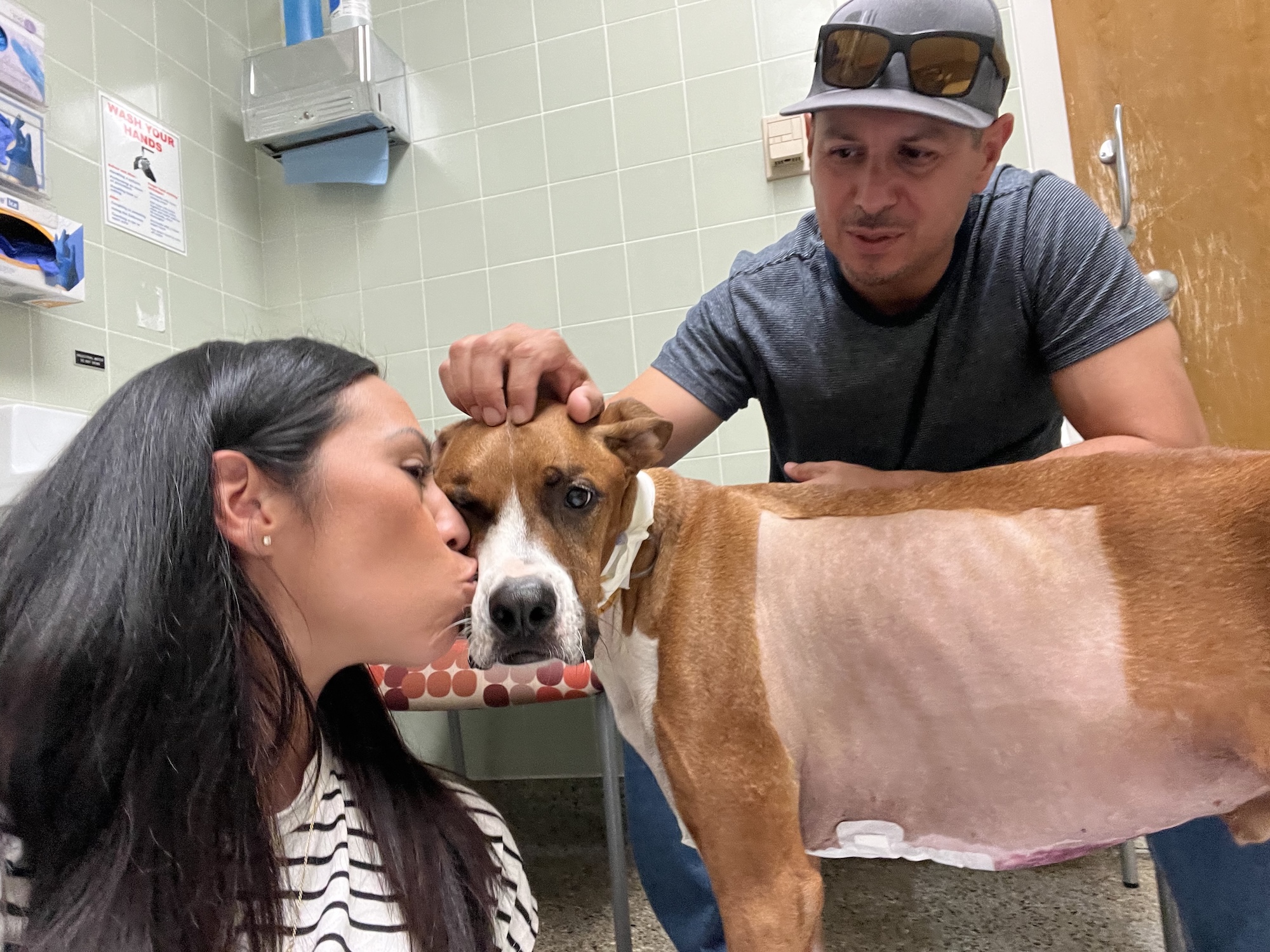
Valley fever can infect both humans and dogs. In the second and final installment of our series examining valley fever, you’ll hear the story of Cooper, a boxer mix from California’s Central Valley. He nearly lost his life to the fungal infection. In this episode of Unfold, we’ll talk to UC Davis scientists working across medicine and veterinary care to study valley fever. You’ll hear not only about one dog’s fight for survival but how dogs may hold the key to predicting valley fever’s spread in humans.
In this episode:
- Dr. Jane Sykes, small animal veterinarian at UC Davis School of Veterinary Medicine with a special interest in infectious diseases
- Dr. Glynn Woods, Veterinarian, UC Davis School of Veterinary Medicine
Omar and Rosemary Rios, owners of Cooper, a dog with valley fever
Learn more about valley fever in both dogs and humans in our in-depth In Focus feature.


Transcript
Transcribed using AI. May contain errors.
Omar Rios
He's super friendly.
Amy Quinton
Cooper, a four-year-old boxer mix, was excited to have visitors at his home in Farmersville, a small town in California's Central Valley. He immediately brought me a stuffed toy. Omar and Rosemary Rios are his human parents.
Marianne Russ Sharp
They adopted him when he was just a puppy, and from the beginning, Omar says he was more than a pet.
Omar Rios
He's not just a dog. People know him. People go to the store, where sheworks, and ask for him, and I go, where's Cooper? I came here just for Cooper. So he's like, yeah, he's just a member of the community, and he's family to us.
Amy Quinton
Rosemary runs an athletic store. She's a runner, and so is Cooper, several miles a day.
Marianne Russ Sharp
So just a year ago, when Cooper's energy started to dip, the Rios's began to worry. He wasn't eating much, but his belly looked full.
Rosemary Rios
after a hike, which he did great on later that evening, when he came home, he had shortness of breath. He was like labored to breathe, and that's when we knew something had to be wrong with him.
Amy Quinton
In fact, that's what you're hearing right now, Cooper struggling to breathe. Rosemary recorded much of his illness.
Marianne Russ Sharp
Their local veterinarian found fluid had built up in his abdomen. Ultimately, they rushed Cooper to UC Davis Veterinary Medical Teaching Hospital.
Rosemary Rios
It was absolutely terrifying as we drove to UC Davis, we really didn't know what we were going in for, but knew that we were willing to do whatever we could to help him.
Marianne Russ Sharp
The diagnosis caught the Rios's off guard: valley fever, a fungal disease. It was one they had heard of, but only in humans.
Amy Quinton
But dogs also get valley fever, and it's showing up in unexpected places.
Marianne Russ Sharp
And as scientists are learning, dogs may be the first to warn us when the fungus is spreading.
Amy Quinton
Dr Jane Sykes is working with researchers and physicians at the Center for Valley Fever at UC Davis Health.
Marianne Russ Sharp
She's a small animal veterinarian with a special interest in infectious diseases.
Jane Sykes
Dogs are close to people. There's lots of dogs. They dig in soil, which puts them at risk of the disease, and so they're potentially really good sentinels or signs that humans might also be getting infected in in a region.
Amy Quinton
In this episode of unfold, you're going to hear not just about one dog's fight for survival. We'll tell you how dogs may hold the key to understanding valley fever and its spread.
Amy Quinton
Coming to you from UC Davis
Marianne Russ Sharp
and UC Davis Health
Amy Quinton
This is Unfold. I'm Amy Quinton.
Marianne Russ Sharp
and I'm Marianne Russ Sharp.
Amy Quinton
The Rios's drove Cooper almost four hours through the night to try to make it to the UC Davis vet hospital before 11 that evening,
Marianne Russ Sharp
Once there, veterinarians drained the fluid that had built up in Cooper's abdomen because of the fungal infection, three liters in all.
Amy Quinton
Dr Glynn Woods, who would become Cooper's main veterinarian, says cardiologists were suspicious that the fluid wasn't coming from his abdomen, but instead his heart.
Glynn Woods
The pericardium, this really tiny layer that encompasses the heart, was markedly thickened, thicker, as almost as thick as my thumb when it should be, you know, cells thick just to gently coat the heart. It was grossly abnormal. And I was like, 'oh my goodness, this is shocking.'
Marianne Russ Sharp
Veterinarians faced a tough decision. The primary treatment for valley fever in dogs and humans is antifungal therapy.
Amy Quinton
But Cooper's heart condition was severe, he needed surgery. Which treatment should come first?
Marianne Russ Sharp
They decided to give Cooper antifungals and wait.
Amy Quinton
But Rosemary says vets told her Cooper just wasn't improving fast enough.
Rosemary Rios
They felt he needed to have the surgery as soon as possible, because he was still filling with fluids and having to drain him so much.
Amy Quinton
they were draining liter after liter and the fluids were putting pressure on his organs.
Marianne Russ Sharp
Surgery would also be risky. Cardiologists found that Cooper's pericardium had adhered to his heart, making it too difficult to remove.
Glynn Woods
What they ultimately done was just create a huge window in the pericardium so it effectively cut a hole delicately into the pericardium to allow the fluid that was entrapping the heart just to flow into the thorax and immediately relieve pressure on the heart.
Amy Quinton
The surgery was successful. Rosemary filmed the moment she and Omar finally saw Cooper after surgery.
Amy Quinton
Cooper, his abdomen shaved, eagerly walks over to them, wagging his tiny tail
Marianne Russ Sharp
Within just a few days, Cooper went home.
Omar Rios
Cooper, you ready to go home? Finally going home after 5 days.
Amy Quinton
But this wasn't the end. It was the start of a marathon.
Glynn Woods
It wasn't a joke how significant the disease burden was on Cooper. The dog still had to fight the fungal infection, which was draining him systemically. We were so chuffed that he came through the surgery well. Then we realized, wait now is the long game.
Marianne Russ Sharp
He would still have to endure numerous antifungal treatments with the drug Amphotericin B, which can be toxic to other organs, and the fungal infection was still causing fluid to build up in his chest.
Amy Quinton
He'd lost 15 pounds and wasn't gaining it back.
Rosemary Rios
There were so many times where we didn't think he was going to make it through. I remember even after his the surgery and continuing treatment. There was a couple times where Dr Woods looked scared and concerned, and he kind of said, well, this really concerns me. We're gonna have to see what happens after this treatment.
Glynn Woods
It's really difficult for me to hide my feelings, and I think the owners were had already come through a lot, but when I kept seeing this dog's weight go down, you do feel you're losing the battle, but we just had to, like, stay the course, give this dog time.
Marianne Russ Sharp
Rosemary was able to drain fluid from Cooper through ports that were surgically placed in his chest.
Amy Quinton
That allowed him to get better at home, rather than making multiple trips to the hospital.
Marianne Russ Sharp
It bought them time. They were all in and Cooper kept fighting.
Amy Quinton
The severity of Cooper's valley fever is rare, but Dr Jane Sykes has seen plenty of dogs with severe valley fever at UC Davis Veterinary Medical Teaching Hospital.
Marianne Russ Sharp
One fungal spore is all it takes to cause infection. She says it usually starts with respiratory signs in dogs, just like in humans. And there are other similarities too.
Jane Sykes
I think we have the same problems as they do in human medicine in dogs, and oftentimes veterinarians are not thinking about valley fever as a diagnosis. And I've had dogs that have been referred up to me because they've been diagnosed with like chronic kennel cough, when in fact they have valley fever.
Amy Quinton
Sykes says valley fever is common in animals, particularly with dogs that like to dig. But she wanted to find out just how prevalent the infection was and whether dog cases could tell us more about the fungus's spread.
Marianne Russ Sharp
She looked at nearly 900,000 blood antibody tests from dogs that had been tested for the infection.
Amy Quinton
They were from across the US between 2012 and 2022. Cases in that time increased as expected. But what else she found amazed her.
Jane Sykes
The first big surprise was just the proportion of animals that tested positive, so we had nearly 38% of the test results were positive. And that's really high when you compare it to other infectious disease studies, where you might see, you know, less than 10% of animals testing positive.
Marianne Russ Sharp
Then, working with colleagues at UC Berkeley, she used the data to map the locations of dog cases.
Jane Sykes
Creating the actual maps actually doesn't take that long. So we're all holding our breath, thinking, what is this going to look like? Is it going to look like what we know about the maps for humans? And then these maps came up, and they were just perfect in terms of what you would expect, what we know about the distribution of the fungus in people.
Amy Quinton
What was perhaps more surprising, positive cases were turning up in states where valley fever is not considered endemic.
Marianne Russ Sharp
The Centers for Disease Control considers it endemic in parts of six states; California, Arizona, Nevada, New Mexico, Texas and Utah.
Amy Quinton
The study also provided insight on its spread in states that aren't required to report human valley fever cases, like Montana and Texas.
Jane Sykes
All of a sudden, we were given this window into what might be going on in these states to know where human disease might be occurring, because now we could see it also in Texas, Montana, Idaho, Oregon, some signs that it could be present in people that might be getting it in those locations without traveling.
Marianne Russ Sharp
She found cases of valley fever in dogs in Washington and Colorado as well. And Sykes says they also compared dog and human cases in both California and Arizona.
Amy Quinton
Both states are known hot spots for the infection. She found the similarities striking.
Jane Sykes
So that was amazing when we saw just how close it was, and a sign that dogs really might be able to help us understand, you know, disease in humans as well.
Marianne Russ Sharp
And that's the next step in her research. She wants to use the data to see what factors besides digging in soil put dogs at risk for contracting valley fever. Could it be similar in humans?
Jane Sykes
There may be, even within that group, these genetically susceptible breeds, and if we can understand the genetic mechanisms of susceptibility in dogs, which have quite homogenous genomes compared with people, then we might be able to also get understanding about genetic risk factors in people.
Amy Quinton
Ultimately, she hopes the data will better protect both pets and people. It's part of a One Health approach, the idea that human, animal and environmental health are all connected.
Marianne Russ Sharp
Back in Farmersville, Cooper is still on antifungal medication, but he's back to his normal weight. He still has ports under his skin, a reminder of all he's been through.
Amy Quinton
Omar Rio says until Cooper was infected, he never knew dogs could get valley fever.
Omar Rios
Most people that we talk to that are dog owners. They don't know as well. Even the doctors, when we took them to a local vet, they did not suspect that it was valley fever they thought it was cancer.
Marianne Russ Sharp
Since then, Omar says valley fever is top of mind for his local vet.
Amy Quinton
Cooper's fight against the infection showed his family and his veterinarians what it means to push through even when the odds were stacked against him.
Marianne Russ Sharp
That left an impression on his care team at UC Davis, including on Dr. Glynn Woods.
Glynn Woods
This dog never moaned. This dog sat there, let me poke and prod, and he's just got this most like docile little face where he just almost stares at you like he's bored, and as he got brighter, you could see his tail starting to wag, and he was like his little bum was shaking. Em, so no, he was he was always in good spirits despite being profoundly unwell.
Amy Quinton
And no one knows his resilience better than Rosemary and Omar Rios.
Rosemary Rios
He is a miracle for sure. He's a fighter, huh Cooper? Yes, you're a fighter.
Marianne Russ Sharp
He's also still a runner. He's not running miles a day like he used to, but Rosemary recorded this joyful jog they took together on Christmas Day.
Rosemary Rios
Good job Cooper, yeah you're running. You're running.
Amy Quinton
And there's more good news. Scientists are hoping to soon bring a vaccine to the market that prevents valley fever in dogs.
Marianne Russ Sharp
It's yet to be approved by the USDA, but researchers are hopeful it might happen soon.
Amy Quinton
And if you want to feel really hopeful, a little bonus track.
Marianne Russ Sharp
I do want to feel hopeful
Amy Quinton
okay. Well, we can't end this podcast episode without sharing the joyful sound of Cooper doing his favorite activity, chasing water from the hose.
Omar Rios
He loves the water. If he gets it, he loses interest if I let him get it too much. He'll play all day.
Marianne Russ Sharp
Oh, that's awesome. I love it.
Amy Quinton
If you want to see photos of Cooper and the Rios's, visit our website.
Marianne Russ Sharp
That's where you'll also find a link to a longer story and video about what UC Davis is doing to help both dogs and humans with valley fever. I'm Marianne Russ Sharp.
Amy Quinton
And I'm Amy Quinton. Thanks for listening.
Andy Fell
Unfold is a production of UC Davis. It's edited by Marianne Russ Sharp. Original music for Unfold comes from Damien Verrett and Curtis Jerome Haynes. Additional music comes from Blue Dot sessions.